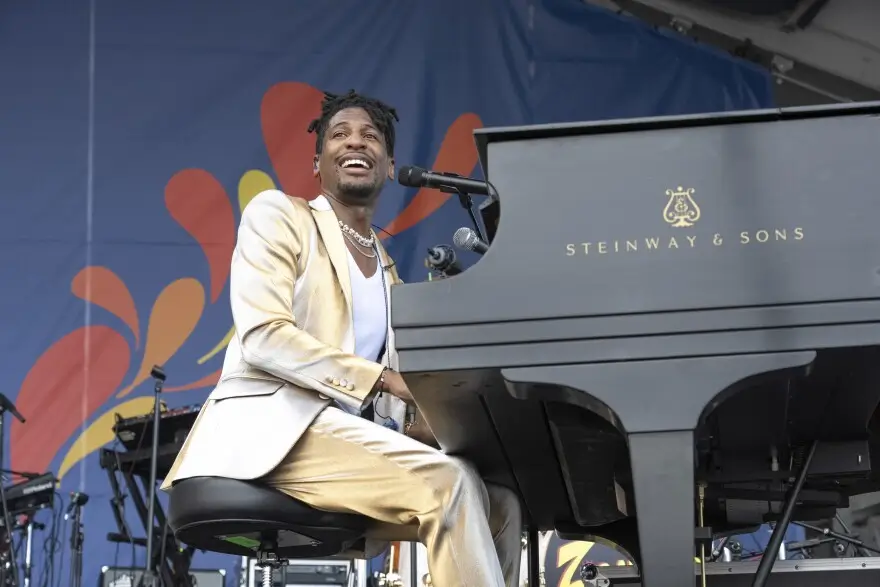a return
“Fightland” isn’t just a new single — it’s a statement. Curtis “50 Cent” Jackson returns to music with a clarity that feels cinematic, dropping a track that folds grit, legacy, and cultural tension into a single sound. Released under G-Unit Records, the song arrives as both the theme for his upcoming STARZ series Fightland and as a standalone anthem built for headphones, locker rooms, and film trailers alike.
50 Cent has never been one to move quietly. When he re-enters a space, he brings with him the total ecosystem — music, image, and motion picture — all synchronized. “Fightland” exemplifies that formula: a modern-day ring walk soundtrack that bridges generations and genres.
artists
The record’s chemistry is its secret weapon. 50 Cent brings together three distinct forces: Brooklyn’s Sheff G and Sleepy Hallow — pillars of the drill movement — and Chicago’s Jeremih, the R&B architect behind some of the past decade’s most enduring hooks. Each one plays a part in the drama: 50 Cent as the strategist, Sheff G as the brawler, Sleepy Hallow as the counterpuncher, Jeremih as the soul and smoke between rounds.
Their verses build like a sparring session. 50 Cent opens with the calm aggression that made him a legend — deliberate, cold, and surgical. Sheff G follows with measured force, weaving his deep tone through street-law metaphors that balance menace and reflection. Sleepy Hallow, lighter on his feet, delivers rapid patterns that feel both agile and world-weary. Jeremih, placed swiftly on the hook, carries the emotional gravity: his voice gliding over the production like a bruised prayer.
struct
“Fightland” opens in darkness. A low hum of brass fades beneath the faint metallic ring of a boxing bell. The percussion lands heavy, unrelenting — a pulse turned into a drumline. 50 Cent’s opening bar lands like a right hook, steady but inevitable. His delivery hasn’t aged; if anything, it’s grown denser. He knows where to leave silence, where to lean into grit.
The beat feels designed for scale — cinematic in texture but street in detail. The bass rolls like an engine idling before ignition. The hi-hats chatter in bursts, echoing the rhythm of quick footwork. Layers of strings slide underneath, suggesting both tension and resolve. By the time Jeremih’s chorus arrives, the atmosphere shifts from confrontation to contemplation. His refrain — “welcome to fightland” — sounds less like a greeting than a warning, or maybe an invitation to endure.
err
The track stands as a meeting point between generations. 50 Cent, who defined early-2000s street realism, collaborates with Sheff G and Sleepy Hallow — artists who have translated that DNA into the language of drill and melodic rap. Jeremih acts as the bridge, linking the visceral aggression of rap with the accessibility of R&B.
The result is cross-era symmetry: 50’s precision, the duo’s momentum, Jeremih’s fluidity. It’s not nostalgia dressed as relevance; it’s evolution performed in real time. 50 Cent doesn’t imitate youth — he curates it. His presence grounds the younger voices, while their hunger sharpens his own cadence. Together, they form a quartet that feels more like a relay than a remix — the baton of resilience passed through rhythm.
gravity
Lyrically, “Fightland” deals in resilience and redemption. It’s a song about scars — not as decoration but as evidence of survival. 50 Cent’s lines play like internal dialogue from someone who’s fought for everything twice: “Ain’t no peace where I’m from, only silence between rounds.” Sheff G’s verses dwell on loyalty, questioning who stands in your corner when the lights fade. Sleepy Hallow contrasts that with forward momentum, rapping about motion as self-defense, the constant hustle as necessity.
Jeremih’s chorus folds it all together. His melody lingers, equal parts gospel and grit. When he sings, “Every night’s another round, but I’m still standin’ now,” it captures the essence of both boxing and life itself — that victory isn’t always triumph but endurance.
flow
Every production element mirrors the show’s cinematic tone. The faint echo of gloves hitting a bag. The reverb that suggests concrete halls and sweating bodies. The tension between orchestral samples and raw drums. It’s the sound of London basements and Queens stairwells stitched together.
That fusion gives “Fightland” its identity. It’s a television theme and a street record at once — the line between soundtrack and single blurred deliberately. When played over visuals of the forthcoming series, it will likely function as emotional shorthand: vengeance, struggle, survival, glory. When played alone, it’s self-contained mythology.
perception
Releasing “Fightland” before the show is textbook 50 Cent strategy. It seeds the narrative through sound, letting audiences build an emotional connection before the first frame hits the screen. It’s a move he’s mastered since Power — using music to set tone and expectation, so that when the visual story arrives, it already feels familiar.
In branding terms, “Fightland” operates like a sonic logo. It expands his creative identity from artist to storyteller to architect. 50 Cent isn’t simply scoring a show; he’s building a cultural world that spans soundtracks, visuals, and merchandising. The song becomes both art and asset.
media
There’s an enduring kinship between hip-hop and boxing. Both disciplines reward endurance, timing, and spectacle. Both turn survival into performance. “Fightland” taps into that lineage — part pugilism, part poetry. The track’s aesthetic — hard drums, hushed spaces, sudden bursts of brass — evokes the moment between fear and focus before a fight begins.
It also reflects 50 Cent’s personal mythology. His entire career has orbited the idea of the comeback, the fighter who refuses to retire, the strategist who survives by adaptation. Sheff G and Sleepy Hallow bring their own battles — navigating fame, controversy, and the realities of drill culture. Jeremih adds a dimension of emotional reflection: the cost of victory, the tenderness behind toughness.
show
Since release, “Fightland” has spread rapidly across playlists, workouts, and social snippets. Fans praise its authenticity — not as a return to the past, but as a reaffirmation of principle. 50 Cent’s delivery feels renewed, confident, almost cinematic in its control. The younger features hold their own; their presence doesn’t dilute the song’s weight but rather electrifies it.
What’s remarkable is the equilibrium: four artists, four energies, no hierarchy. 50 Cent may headline, but every voice lands as essential. The final mix sounds less like a feature record and more like an ensemble — a modern rap opera where every verse advances the plot.
fin
“Fightland” is more than music — it’s motion. It’s the sound of discipline wrapped in drama, the meeting point between past and future. 50 Cent, Sheff G, Sleepy Hallow, and Jeremih turn what could have been a marketing single into a fully realized story. The title becomes emblematic: life as a battleground, success as endurance, sound as self-defense.
As both single and symbol, Fightland proves that the fight isn’t just physical — it’s creative, emotional, generational. 50 Cent remains the master of turning struggle into spectacle, and here, surrounded by hungry new energy and cinematic scope, he does exactly that. The result is something rare: a record that feels like both a punch and a prophecy.
No comments yet.








